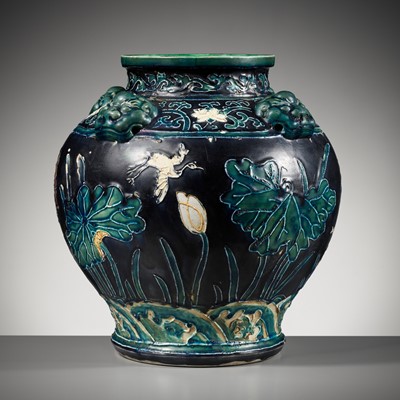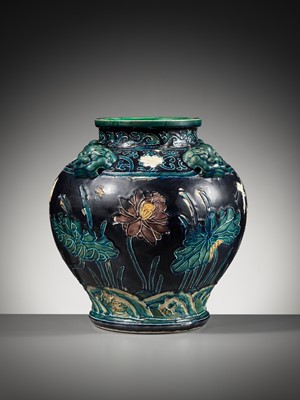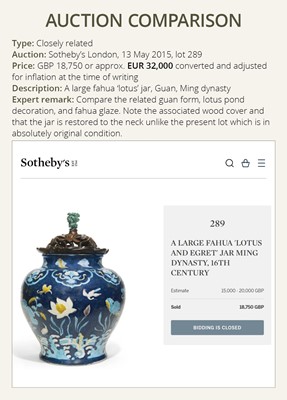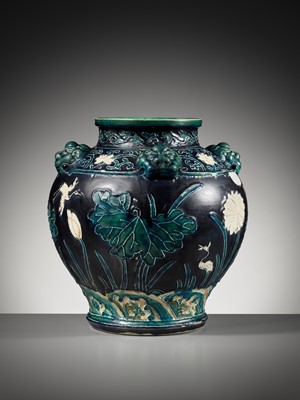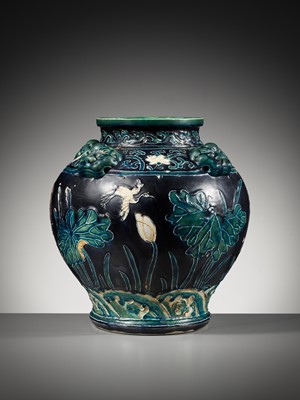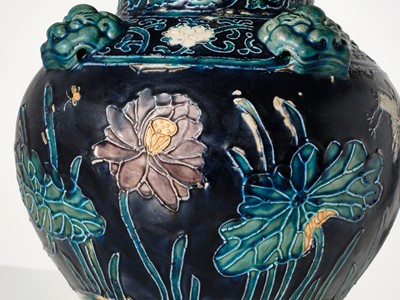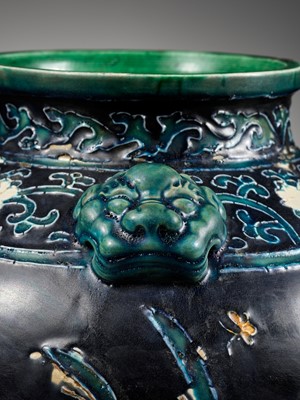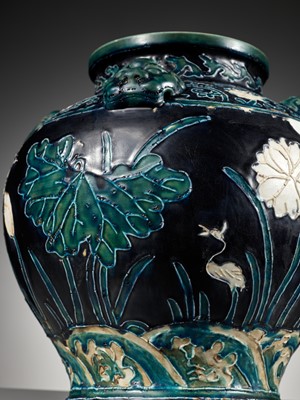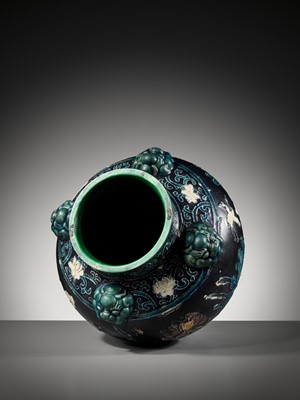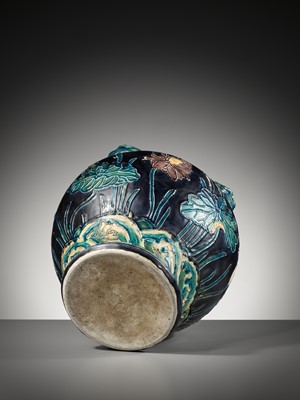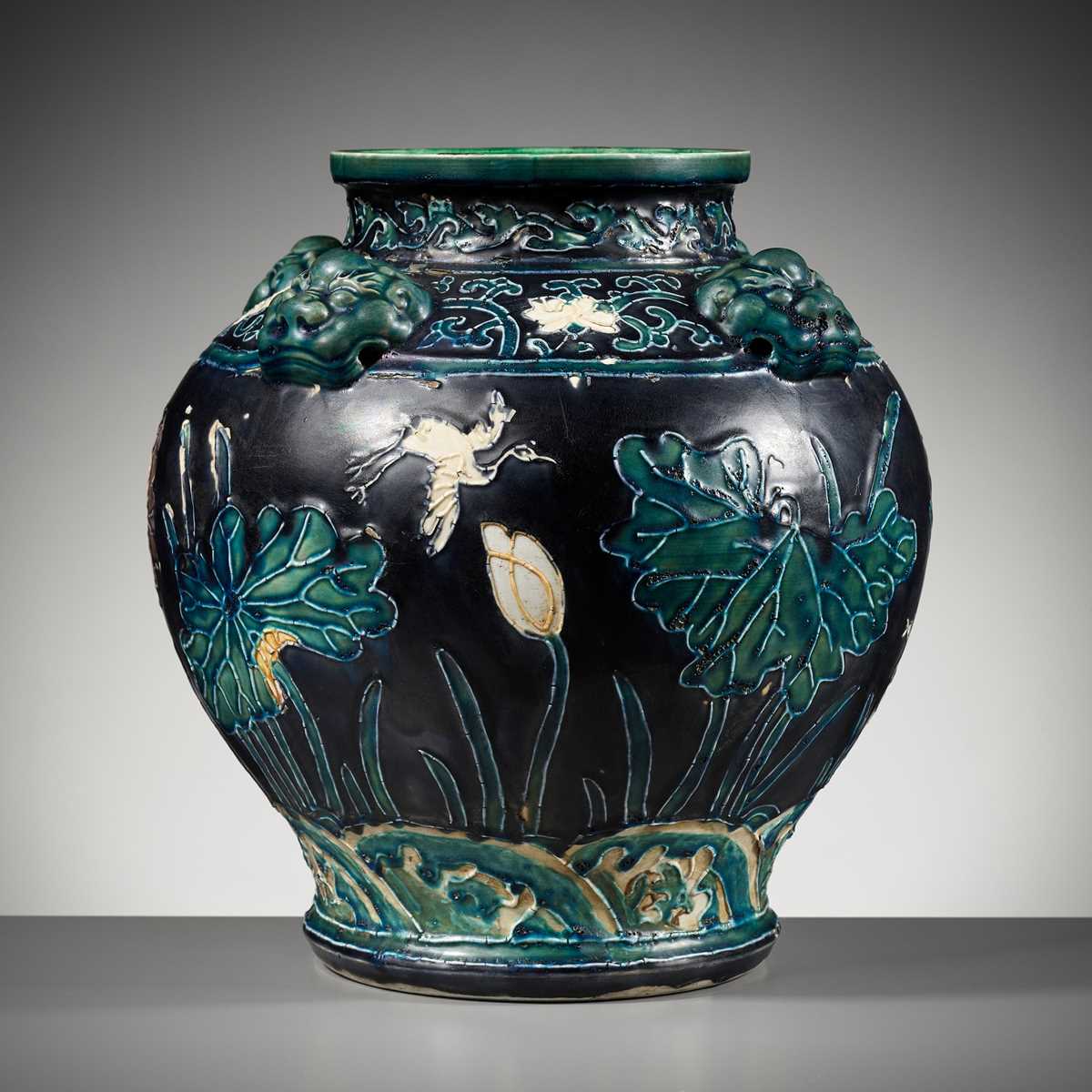11th Oct, 2023 11:00
THREE-DAY AUCTION - Fine Chinese Art / 中國藝術集珍 / Buddhism & Hinduism
84
AN EARLY FAHUA-GLAZED ‘LOTUS’ JAR, GUAN, WITH FOUR LION-MASK HANDLES, MING DYNASTY
明代琺華釉蓮花罐
Sold for €7,800
including Buyer's Premium
Expert’s note: The lion mask-handles in such high relief are extremely rare in fahua-glazed Guan jars of this type. While they did exist with other styles of fahua vessels, like the stools at Sotheby’s referenced in the literature comparison below, no other jars of this type are recorded in public or private collections.
China, late 15th to early 16th century. Heavily potted with a baluster body supported on a short tapered foot and rising to a short waisted neck with a galleried rim. The exterior is slip decorated and brightly glazed in blue, turquoise, aubergine, yellow, and cream with two egrets, one standing and the other flying, in a lotus pond with blossoms, buds, and leaves, in the back with a small butterfly, all above crashing waves. The shoulder encircled by a band of lotus scroll and applied with four pierced lion-mask handles that once suspended loose bronze rings, below a band of foliate scroll to the neck.
Provenance: From the Langlois Collection. Jean-Marie-Charles Langlois (1896-1949) arrived in Vietnam in 1920, where he served as the principal engineer for the Indochinese railways until 1949. As a sinophile who spoke fluent Mandarin, he built an important collection of Asian works of art. In 1949, he was imprisoned by the Viet Minh during a train attack and executed on the same day. His wife and two sons came back to Burgundy near Dijon, France, bringing Jean Langlois’ collection with them. Once in France, his family continued to buy Asian works of art on the French art market, thus paying tribute to Jean Langlois's memory.
Condition: The raised slip is remarkably well preserved. The jar remains in its absolutely original condition with no restorations of any kind. Obvious glaze losses as seen on images, some of them smoothened. Old wear, expected firing flaws, shallow surface scratches and tiny nicks. Displaying exceptionally well, despite its age of roughly half a millennia.
Weight: 4,451 g
Dimensions: Height 28.8 cm
Please click here to read the full description
The term 'fahua' may derive from the Chinese term 'fenhua', meaning 'powdered decoration' and refers to a group of medium-fired glazes developed in the late 15th century on the basis of the Yuan Dynasty liu li glazes (see Q. Wang, A Dictionary of Chinese Ceramics, Shanghai, 1989, p. 220). Due to the very liquid nature of the glazes, the variously colored areas are isolated from one another by clay walls which tend to vary in thickness.
Variations in the vivacity of the colors applied, as well as different shapes and subjects of decoration, may be attributed to different eras of production (see D. Lion-Goldschmidt, Ming Porcelain, London, 1978, p. 127). On this matter, Lion-Goldschmidt also notes that the early fahua wares tend to feature motifs of lotus rising from water, as well as cranes, birds, and figures. The author further points out that complimentary decoration on fahua, i.e. that found on necks, rims, and feet, also relates to the designs, found on late 15th century blue and white wares.
Egrets or cranes provide a homonym for ‘lu’ (‘a path’), alluding to attainment. When this imagery is combined with flowering lotus (lian) it forms the rebus, ‘Yilu lianke’ (‘May you pass your exams one after another’).
Literature comparison:
Compare a related pair of fahua-glazed stools also decorated with egrets in a lotus pond and applied with similar lion-mask handles suspending gilt-bronze rings, 44 cm high, dated to the Ming dynasty, at Sotheby’s Paris, 11 April 2018, lot 305.
Auction result comparison:
Type: Closely related
Auction: Sotheby’s London, 13 May 2015, lot 289
Price: GBP 18,750 or approx. EUR 32,000 converted and adjusted for inflation at the time of writing
Description: A large fahua ‘lotus’ jar, Guan, Ming dynasty
Expert remark: Compare the related guan form, lotus pond decoration, and fahua glaze. Note the associated wood cover and that the jar is restored to the neck unlike the present lot which is in absolutely original condition.
点此阅读中文翻译 (Chinese Translation)
明代琺華釉蓮花罐
中國,十五世紀末至十六世紀初。罐厚胎,直口,弦唇,短頸,溜肩,鼓腹。外壁自上而下用弦線分隔成三個紋樣帶。從上而下可見卷葉紋、纏枝蓮紋與福山壽海蓮池紋。蓮池中有兩隻白鷺,一立一飛,荷塘中花芽葉葉,上有一隻小蝴蝶。肩部四個獅面輔首。琺華彩,外壁施青、綠、紫、黃、白色,釉色明亮。
專家注釋:如此高浮雕的獅面輔首,在此類琺華彩罐中極為罕見。 雖然它們確實與其他風格的琺華器一起存在,例如下面文獻比較中提到的蘇富比拍賣行的凳子,但公共或私人收藏中沒有記錄其他此類罐子。
來源:Langlois 收藏。Jean-Marie-Charles Langlois (1896-1949) 1920 年到了越南,並在 1949 年之前擔任印度支那鐵路的首席工程師。作為一名能說一口流利普通話的中國文化愛好者,他收藏了大量重要的亞洲藝術品。1949年,他在一次火車襲擊中被越盟監禁並於同一天被處決。他的妻子和兩個兒子帶著 Jean Langlois 的收藏回到了法國第戎附近的勃艮第。抵達法國後,他的家人繼續在法國藝術市場上購買亞洲藝術品,以此緬懷他。
品相:保存得非常好。該罐子保留了原始狀態,沒有任何形式的修復。從圖像上可以看到明顯的釉面損失,其中一些已經平滑。 磨損、預期的燒製缺陷、淺表面劃痕和微小刻痕。儘管已有大約半個千年的歷史,但仍表現得非常好。
重量:4,451 克
尺寸:高 28.8 厘米
“琺華”一詞指的是十五世紀末在元代琉璃釉的基礎上發展起來的低温陶瓷(見汪慶正《中國陶瓷詞典》,上海,1989 年,第 220 頁)。 由於釉料具有流動的性質,不同顏色的區域被厚度不同的粘土壁相互隔離。
所用顏色的鮮豔度,以及裝飾的不同形狀和主題的變化可能歸因於其不同的生產時代(參見 D. Lion-Goldschmidt,Ming Porcelain,倫敦,1978 年,第 127 頁)。 對此,Lion-Goldschmidt還指出,早期的琺華器往往以出水蓮花、仙鶴、飛禽和人物為圖案。 作者進一步指出,琺華器上的裝飾,頸部、口沿和足部的裝飾,也與十五世紀末青花瓷上的圖案有關。
白鷺或鶴與“路”同音,象徵成就,與蓮花結合在一起時,就形成了“一路連科”。
文獻比較:
比較一對相近的明代法華釉凳,亦飾荷塘白鷺,柄上類似獅面,柄上懸鎏金銅環,高44 釐米,見巴黎蘇富比,2018年4月11日,lot 305。
拍賣結果比較:
形制:非常相近
拍賣:倫敦蘇富比,2015年5月13日,lot 289
價格:GBP 18,750(相當於今日EUR 32,000)
描述:明代法華蓮紋罐
專家評論:比較相近的罐外形、蓮紋和法華。請注意有相應的木蓋,且頸部曾被修補過。
Expert’s note: The lion mask-handles in such high relief are extremely rare in fahua-glazed Guan jars of this type. While they did exist with other styles of fahua vessels, like the stools at Sotheby’s referenced in the literature comparison below, no other jars of this type are recorded in public or private collections.
China, late 15th to early 16th century. Heavily potted with a baluster body supported on a short tapered foot and rising to a short waisted neck with a galleried rim. The exterior is slip decorated and brightly glazed in blue, turquoise, aubergine, yellow, and cream with two egrets, one standing and the other flying, in a lotus pond with blossoms, buds, and leaves, in the back with a small butterfly, all above crashing waves. The shoulder encircled by a band of lotus scroll and applied with four pierced lion-mask handles that once suspended loose bronze rings, below a band of foliate scroll to the neck.
Provenance: From the Langlois Collection. Jean-Marie-Charles Langlois (1896-1949) arrived in Vietnam in 1920, where he served as the principal engineer for the Indochinese railways until 1949. As a sinophile who spoke fluent Mandarin, he built an important collection of Asian works of art. In 1949, he was imprisoned by the Viet Minh during a train attack and executed on the same day. His wife and two sons came back to Burgundy near Dijon, France, bringing Jean Langlois’ collection with them. Once in France, his family continued to buy Asian works of art on the French art market, thus paying tribute to Jean Langlois's memory.
Condition: The raised slip is remarkably well preserved. The jar remains in its absolutely original condition with no restorations of any kind. Obvious glaze losses as seen on images, some of them smoothened. Old wear, expected firing flaws, shallow surface scratches and tiny nicks. Displaying exceptionally well, despite its age of roughly half a millennia.
Weight: 4,451 g
Dimensions: Height 28.8 cm
Please click here to read the full description
The term 'fahua' may derive from the Chinese term 'fenhua', meaning 'powdered decoration' and refers to a group of medium-fired glazes developed in the late 15th century on the basis of the Yuan Dynasty liu li glazes (see Q. Wang, A Dictionary of Chinese Ceramics, Shanghai, 1989, p. 220). Due to the very liquid nature of the glazes, the variously colored areas are isolated from one another by clay walls which tend to vary in thickness.
Variations in the vivacity of the colors applied, as well as different shapes and subjects of decoration, may be attributed to different eras of production (see D. Lion-Goldschmidt, Ming Porcelain, London, 1978, p. 127). On this matter, Lion-Goldschmidt also notes that the early fahua wares tend to feature motifs of lotus rising from water, as well as cranes, birds, and figures. The author further points out that complimentary decoration on fahua, i.e. that found on necks, rims, and feet, also relates to the designs, found on late 15th century blue and white wares.
Egrets or cranes provide a homonym for ‘lu’ (‘a path’), alluding to attainment. When this imagery is combined with flowering lotus (lian) it forms the rebus, ‘Yilu lianke’ (‘May you pass your exams one after another’).
Literature comparison:
Compare a related pair of fahua-glazed stools also decorated with egrets in a lotus pond and applied with similar lion-mask handles suspending gilt-bronze rings, 44 cm high, dated to the Ming dynasty, at Sotheby’s Paris, 11 April 2018, lot 305.
Auction result comparison:
Type: Closely related
Auction: Sotheby’s London, 13 May 2015, lot 289
Price: GBP 18,750 or approx. EUR 32,000 converted and adjusted for inflation at the time of writing
Description: A large fahua ‘lotus’ jar, Guan, Ming dynasty
Expert remark: Compare the related guan form, lotus pond decoration, and fahua glaze. Note the associated wood cover and that the jar is restored to the neck unlike the present lot which is in absolutely original condition.
点此阅读中文翻译 (Chinese Translation)
明代琺華釉蓮花罐
中國,十五世紀末至十六世紀初。罐厚胎,直口,弦唇,短頸,溜肩,鼓腹。外壁自上而下用弦線分隔成三個紋樣帶。從上而下可見卷葉紋、纏枝蓮紋與福山壽海蓮池紋。蓮池中有兩隻白鷺,一立一飛,荷塘中花芽葉葉,上有一隻小蝴蝶。肩部四個獅面輔首。琺華彩,外壁施青、綠、紫、黃、白色,釉色明亮。
專家注釋:如此高浮雕的獅面輔首,在此類琺華彩罐中極為罕見。 雖然它們確實與其他風格的琺華器一起存在,例如下面文獻比較中提到的蘇富比拍賣行的凳子,但公共或私人收藏中沒有記錄其他此類罐子。
來源:Langlois 收藏。Jean-Marie-Charles Langlois (1896-1949) 1920 年到了越南,並在 1949 年之前擔任印度支那鐵路的首席工程師。作為一名能說一口流利普通話的中國文化愛好者,他收藏了大量重要的亞洲藝術品。1949年,他在一次火車襲擊中被越盟監禁並於同一天被處決。他的妻子和兩個兒子帶著 Jean Langlois 的收藏回到了法國第戎附近的勃艮第。抵達法國後,他的家人繼續在法國藝術市場上購買亞洲藝術品,以此緬懷他。
品相:保存得非常好。該罐子保留了原始狀態,沒有任何形式的修復。從圖像上可以看到明顯的釉面損失,其中一些已經平滑。 磨損、預期的燒製缺陷、淺表面劃痕和微小刻痕。儘管已有大約半個千年的歷史,但仍表現得非常好。
重量:4,451 克
尺寸:高 28.8 厘米
“琺華”一詞指的是十五世紀末在元代琉璃釉的基礎上發展起來的低温陶瓷(見汪慶正《中國陶瓷詞典》,上海,1989 年,第 220 頁)。 由於釉料具有流動的性質,不同顏色的區域被厚度不同的粘土壁相互隔離。
所用顏色的鮮豔度,以及裝飾的不同形狀和主題的變化可能歸因於其不同的生產時代(參見 D. Lion-Goldschmidt,Ming Porcelain,倫敦,1978 年,第 127 頁)。 對此,Lion-Goldschmidt還指出,早期的琺華器往往以出水蓮花、仙鶴、飛禽和人物為圖案。 作者進一步指出,琺華器上的裝飾,頸部、口沿和足部的裝飾,也與十五世紀末青花瓷上的圖案有關。
白鷺或鶴與“路”同音,象徵成就,與蓮花結合在一起時,就形成了“一路連科”。
文獻比較:
比較一對相近的明代法華釉凳,亦飾荷塘白鷺,柄上類似獅面,柄上懸鎏金銅環,高44 釐米,見巴黎蘇富比,2018年4月11日,lot 305。
拍賣結果比較:
形制:非常相近
拍賣:倫敦蘇富比,2015年5月13日,lot 289
價格:GBP 18,750(相當於今日EUR 32,000)
描述:明代法華蓮紋罐
專家評論:比較相近的罐外形、蓮紋和法華。請注意有相應的木蓋,且頸部曾被修補過。
Zacke Live Online Bidding
Our online bidding platform makes it easier than ever to bid in our auctions! When you bid through our website, you can take advantage of our premium buyer's terms without incurring any additional online bidding surcharges.
To bid live online, you'll need to create an online account. Once your account is created and your identity is verified, you can register to bid in an auction up to 12 hours before the auction begins.
Intended Spend and Bid Limits
When you register to bid in an online auction, you will need to share your intended maximum spending budget for the auction. We will then review your intended spend and set a bid limit for you. Once you have pre-registered for a live online auction, you can see your intended spend and bid limit by going to 'Account Settings' and clicking on 'Live Bidding Registrations'.
Your bid limit will be the maximum amount you can bid during the auction. Your bid limit is for the hammer price and is not affected by the buyer’s premium and VAT. For example, if you have a bid limit of €1,000 and place two winning bids for €300 and €200, then you will only be able to bid €500 for the rest of the auction. If you try to place a bid that is higher than €500, you will not be able to do so.
Online Absentee and Telephone Bids
You can now leave absentee and telephone bids on our website!
Absentee Bidding
Once you've created an account and your identity is verified, you can leave your absentee bid directly on the lot page. We will contact you when your bids have been confirmed.
Telephone Bidding
Once you've created an account and your identity is verified, you can leave telephone bids online. We will contact you when your bids have been confirmed.
Classic Absentee and Telephone Bidding Form
You can still submit absentee and telephone bids by email or fax if you prefer. Simply fill out the Absentee Bidding/Telephone bidding form and return it to us by email at office@zacke.at or by fax at +43 (1) 532 04 52 20. You can download the PDF from our Upcoming Auctions page.
How-To Guides
How to Create Your Personal Zacke Account
How to Register to Bid on Zacke Live
How to Leave Absentee Bids Online
How to Leave Telephone Bids Online
中文版本的操作指南
创建新账号
注册Zacke Live在线直播竞拍(免平台费)
缺席投标和电话投标
Third-Party Bidding
We partner with best-in-class third-party partners to make it easy for you to bid online in the channel of your choice. Please note that if you bid with one of our third-party online partners, then there will be a live bidding surcharge on top of your final purchase price. You can find all of our fees here. Here's a full list of our third-party partners:
- 51 Bid Live
- EpaiLive
- ArtFoxLive
- Invaluable
- LiveAuctioneers
- the-saleroom
- lot-tissimo
- Drouot
Please note that we place different auctions on different platforms. For example, in general, we only place Chinese art auctions on 51 Bid Live.
Bidding in Person
You must register to bid in person and will be assigned a paddle at the auction. Please contact us at office@zacke.at or +43 (1) 532 04 52 for the latest local health and safety guidelines.
